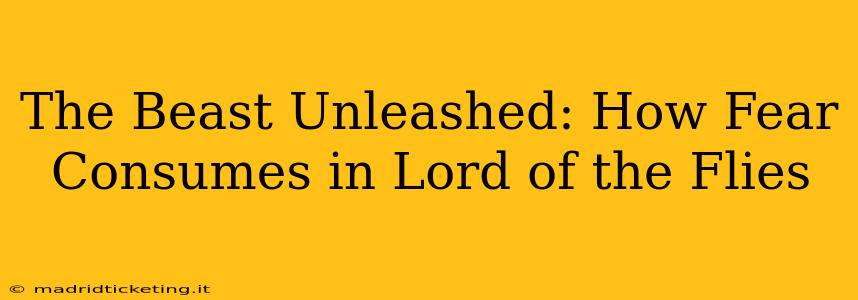William Golding's Lord of the Flies isn't just a gripping adventure story; it's a chilling exploration of human nature, specifically how easily fear can consume and corrupt even the most innocent individuals. The "beast," a terrifying, ambiguous presence, is less a literal creature and more a manifestation of the boys' primal fears and inherent savagery. This essay will delve into how fear, fueled by uncertainty and isolation, unravels the fragile civility of the stranded boys, ultimately leading to their descent into brutality.
What is the Beast in Lord of the Flies?
This is arguably the most crucial question regarding the novel. The beast isn't a physical entity lurking in the jungle; it's a psychological construct, a projection of the boys' anxieties. It represents their fear of the unknown, their fear of death, and, most significantly, their fear of their own inherent capacity for violence. The "beast" embodies the darkness within each boy, a darkness that manifests differently depending on their individual personalities and experiences.
Is the Lord of the Flies the Beast?
The Lord of the Flies, the pig's head impaled on a stick, becomes a tangible symbol of the beast. It's a grotesque representation of their savagery, attracting flies and embodying the decay and corruption taking over the island. Simon's epiphany reveals the Lord of the Flies as the embodiment of the inherent evil within humanity, a beast not found in the jungle but within themselves. This is a critical distinction: the beast isn't something external; it is internalized, a primal force unleashed by their fear and isolation.
How does fear affect the boys' behavior?
Fear acts as a catalyst for the boys' descent into savagery. Initially, their fear of being rescued late fuels a desperate attempt at maintaining order. However, as time passes and the island's isolation sets in, fear transforms. The unknown jungle, the whispers of a beast, and the escalating paranoia amplify their anxieties, leading to irrational actions and decisions. This fear manifests in several ways:
-
Paranoia and Suspicion: The boys become increasingly distrustful of one another, fueled by fear and a lack of clear leadership. Accusations and scapegoating become common, further eroding the fragile social structure.
-
Ritualistic Behavior: The creation of a "Lord of the Flies" and the subsequent hunting rituals reflect a desperate attempt to appease the beast and control their fear through symbolic actions. This highlights the boys' vulnerability and their attempt to find order in chaos through primitive means.
-
Violence and Aggression: As fear intensifies, so does the violence. The hunting of the pig becomes increasingly brutal, evolving from a necessary act of survival into a bloodthirsty expression of primal instincts. This violence is directly linked to their fear, a release of pent-up anxiety and aggression.
How does the setting contribute to the boys' fear?
The isolated island setting plays a significant role in amplifying the boys' fears. The dense jungle, shrouded in mystery, becomes a breeding ground for speculation and paranoia. The lack of adult supervision and the absence of familiar comforts exacerbate their vulnerability and intensify their anxieties. The island, initially a source of adventure, transforms into a place of terror as their fear takes hold.
What are the consequences of unchecked fear?
The unchecked fear that consumes the boys leads to catastrophic consequences. Their descent into savagery results in the death of Piggy and the near-death of Ralph, symbolizing the complete breakdown of civilization and the triumph of primal instincts over reason. The novel serves as a stark warning of the destructive power of fear, highlighting the importance of maintaining order, reason, and empathy in the face of adversity. The unchecked fear underscores the fragility of civilization and the inherent capacity for violence within humanity.
Conclusion: The Beast Within
The "beast" in Lord of the Flies is not a mythical creature, but rather a potent symbol of the destructive power of fear. Golding's masterful storytelling illuminates how fear, fueled by uncertainty, isolation, and the unknown, can erode morality, trigger violence, and ultimately lead to the destruction of civilization. The novel serves as a timeless cautionary tale, highlighting the importance of confronting our own inner demons and maintaining our humanity in the face of adversity.

